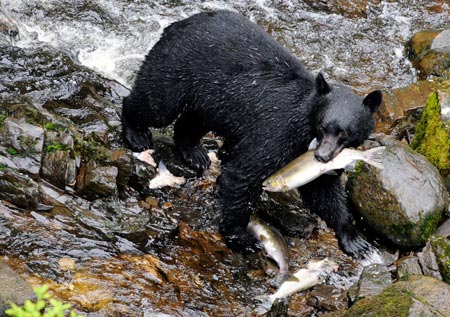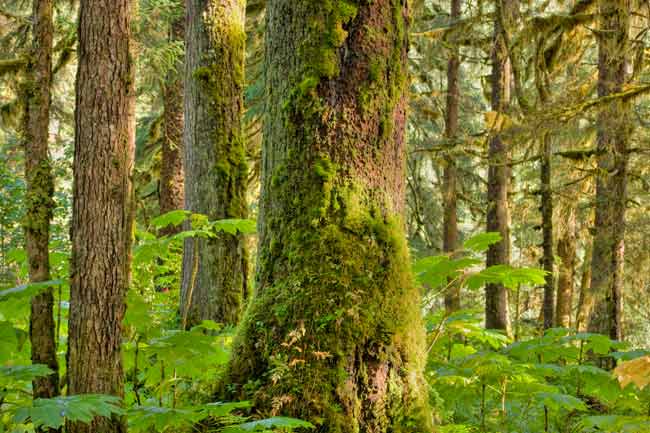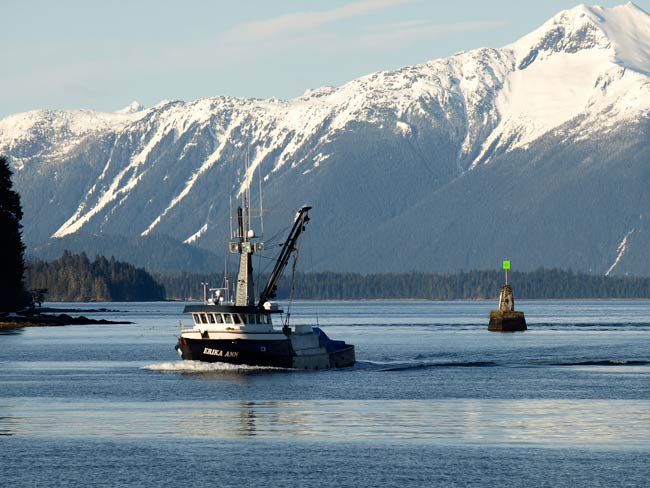Once the heart of dozens of logging towns, Tongass National Forest is now shifting its focus from timber to salmon, creating a ripple effect for local economies and ecosystems alike.
By Paula Dobbyn

Jim Leslie’s life used to revolve around cutting old-growth timber. These days the Vietnam vet and longtime resident of Wrangell, Alaska, makes his living behind the wheel of jet boats, ferrying visitors to picturesque areas to view wildlife, glaciers and salmon.
“My bread and butter is the independent traveler,” he says.
Leslie’s career transition is not uncommon these days in towns scattered across the 17-million-acre Tongass National Forest, a lush and remote place known more for its heated environmental battles than for its tidewater glaciers, humpback whales and zip-line adventures. But change is afoot in this far-flung corner of the United States.
Increasingly, the rain-drenched Tongass of Southeast Alaska is becoming known as a salmon forest and a tourist destination. As the economy of Tongass dramatically shifts, the area’s main landlord — the U.S. Forest Service — is counting on people like Leslie to chart a new course for America’s largest and most rugged national forest.
In the words of Regional Forester Beth Pendleton, top Forest Service official in Tongass, “This time is ripe for an infusion of new opportunities and energy.”
A FOREST OF FISH

Created by President Theodore Roosevelt more than a century ago, Tongass is a coastal temperate rainforest roughly the size of West Virginia. With precious little old-growth forest left in the U.S., Tongass offers the country’s largest remaining swath of ancient forest, as well as an estimated one third of the world’s remaining temperate rainforest. Species that have declined or disappeared elsewhere, such as brown bears and wild salmon, flourish here.
The western hemlock, Sitka spruce, western redcedar and Alaska cedar stands that dominate Tongass are dense and sometimes nearly impenetrable. It’s not just the towering height of the trees that makes Tongass formidable. Devil’s Club, a medicinal but monstrously thorny shrub that makes contact with skin a painful affair, is common throughout the forest. Where there’s no Devil’s Club, downed logs, streams, lakes or muskeg typically define the Tongass landscape. For humans to navigate Tongass, it takes an established trail, a boat or an aircraft. For salmon, it’s quite different.
Some 15,700 miles of rivers and another 4,100 lakes and ponds in Tongass are home to salmon, making the forest a giant breeding and nursing ground. The river systems and estuaries act like a complex freeway system through which salmon navigate to reach their desired destinations. Tongass’ pink, silver, sockeye, Chinook and chum salmon spend their early life in the forest’s freshwater arteries before trading the forest environment for the ocean. After several years and thousands of miles of saltwater migration, salmon use their internal homing mechanisms to return to their natal streams to spawn.
Every year, Tongass produces prodigious volumes of all five species of Pacific salmon found in North America. An estimated 70 percent of all salmon harvested from national forests originate in Tongass, largely because of the extent of intact habitat that remains in Southeast Alaska.

“It’s an incredible fish factory,” says Trout Unlimited’s Southeast Alaska project director and former fly-fishing guide Mark Kaelke.
On average, commercial fishermen in Southeast Alaska catch 48 million wild salmon each year in what is considered a tightly regulated and well-managed fishery with healthy population numbers. Sport fishermen catch another million.
Besides salmon and trout, which support one in 10 regional jobs, other fish species that abound in Tongass include steelhead, Dolly Varden, halibut, lingcod, crab and shrimp, to name a few. According to the Alaska Seafood Marketing Institute, gross earnings from commercial fishing in Southeast Alaska in 2009 totaled $173.4 million. That same year, Southeast Alaska had a seafood industry workforce of some 10,150.
While fishing is booming in this part of the world, the once-robust timber industry, by contrast, is in sharp decline. According to the Forest Service, Tongass timber sales in 2011 generated just $3.3 million in revenue. The logging industry supported only 200 private-sector jobs, the lowest level in five decades.
In the 1990s, Leslie saw this change coming.

THE DECLINE OF TIMBER
For many years, Leslie owned a logging company. He employed about 75 people in seven camps throughout Tongass. Times were good for about two decades for Leslie Cutting Inc., with employees logging between 180 and 220 million board feet a year of hemlock, spruce and cedar trees. Leslie’s company attracted family men like himself who wanted to put down roots and work hard.
“When I got into the industry, it was rough and tumble. One of my goals was to bring civility to it,” Leslie says.
A former board member of the Alaska Forest Association, the state’s main timber trade group, Leslie figured he would operate his company until retirement. But changing market conditions, growing public opposition to clear-cut logging of national forests and passage of the Tongass Timber Reform Act crippled the business environment. Lack of available timber forced Leslie to close his business in 1992. Wrangell’s primary employer, a large sawmill a few miles outside town, closed in 1995. Hundreds of residents lost jobs.
Leslie admits he felt bitter. “I had a chip on my shoulder as large as a load of logs,” he says.
But Leslie isn’t one to mope. From Wrangell’s downtown harbor, he noticed cruise ships starting to bring hundreds of thousands of visitors to Southeast Alaska, and he figured he might have a shot at cashing in. Soon after closing his original business, Leslie became president of the Wrangell Chamber of Commerce and opened a new company — Alaska Waters Inc., an adventure-tourism operation that offers bear and glacier viewing, bird watching, and geological and Alaska native cultural excursions.
The company has allowed Leslie to move on. While the recession took a bite out of business, it’s coming back, he says. And he has few regrets about the changes life forced upon him: “I don’t look back.”
A TIME OF TRANSITION
During the first half of the 20th century, logging in Tongass was small scale. But in 1954, the U.S. government signed a 50-year contract and agreed to supply a newly built Ketchikan-based pulp mill with a massive volume of timber — some 8.25 billion board feet.
Four years later, a second large pulp mill opened in Sitka, also underpinned by a 50-year contract with the Forest Service for 5.25 billion board feet of Tongass old-growth timber.

In their heyday, the Alaska pulp mills employed hundreds of people and, for many years, operated with little notice. In the late 1960s, with the rise of the environmental movement and the subsequent passage of federal clean water and air laws, attitudes toward the pulp mills sharply changed. Heated public debate and environmental lawsuits ensued. In 1990, Congress finally stepped in and passed the Tongass Timber Reform Act, which scaled back logging in favor of fish and wildlife protection. The law ushered in a new era of forest management in Tongass.
Now, more than two decades later, change continues to define this region of jagged fjords and mist-shrouded islands. One of the bigger developments occurred in May 2010, when the Forest Service pledged to move beyond old-growth logging and start managing Tongass for second-growth timber, begin restoring watersheds impacted by logging and support job creation in fishing, renewable energy, mariculture and tourism.
Although some said the policy shift was overdue and simply reflected realities on the ground, the announcement was significant for an agency whose primary focus for decades had been managing Tongass for industrial-scale, old-growth timber harvesting.
The order came from U.S. Secretary of Agriculture Tom Vilsack, who directed the Forest Service to develop a Tongass “Transition Framework,” a strategy that would refocus the agency’s priorities and help grow the regional economy.
Since making the announcement, the Forest Service has organized some 30 job-creating initiatives in collaboration with business, government, tribal and non-profit organizations. It’s called the “cluster initiative,” a process that’s been infused with $30 million from Vilsack’s department. Since 2009, the agency has also invested more than $153 million in infrastructure, education and training, research, and business loans and grants to communities experiencing job declines in the timber industry, according to the Forest Service.
Depending on one’s vantage point, the “transition,” as it’s known locally, either means promising times or frustrating reminders that Tongass’ timber industry is unlikely to ever recover its former past.
RESTORING WATERSHEDS
Fishermen and tourism operators tend to take a more positive view. Many who felt the Forest Service long relegated their priorities to the back burner are hopeful that fish and the environment will finally get more attention.
“Like any change, it takes time to gain momentum. Of course, I would like to see it happen faster. I think people are still getting used to the idea of making the transition,” says Sheila Peterson, a Juneau commercial fisherman who owns Taku River Reds, a direct-market seafood business that sells wild sockeye and silver salmon to high-end restaurants and markets in the lower 48 states.
Peterson’s company depends on healthy, salmon-producing watersheds. While encouraged by the transition, Peterson is among a growing cadre of fishermen who would like to see the Forest Service spend more money and energy restoring watersheds that were damaged by logging. She considers it a key marker of the transition’s success. A retired legislative aide, Peterson was among a group of commercial and sport fishermen that recently lobbied Congress for increased restoration funding.
“Tongass is our backyard. We live and breathe in that environment. And when one part of it is not as healthy as it should be, it’s disturbing, especially for the salmon, an annual reminder of the lifecycles that go on in the forest,” says Peterson.
The Forest Service has identified about 70 key Tongass watersheds that need habitat restoration so that wildlife populations will return to pre-logging levels, especially salmon, trout, steelhead and deer — a crucial subsistence and sport species. Agency estimates put the total cost of restoration at about $100 million. At the current investment rate of anywhere from $1.5 million to $4 million a year, it’ll take as many as five decades to accomplish this work.
Southeast Alaska had a record salmon catch in 2011, with commercial fishermen hauling in more than 73 million salmon and fetching more than $200 million — the most valuable harvest since Alaska became a state. Given the downturn in logging and the growth of the Southeast fishing industry, some fishermen and conservationists argue that the Forest Service should shift its budget priorities in Tongass, which, despite recent developments, still focus heavily on timber and road building.
“Salmon and trout are a huge industry in Southeast Alaska. It’s about $1 billion a year in economic contribution to the region’s economy. It makes sense to put more funding into projects that will increase our runs,” says Juneau gill netter Jev Shelton.
Trout Unlimited’s Kaelke also notes that more than 7,300 jobs are tied to salmon and trout fishing in Southeast Alaska. “The Forest Service budget needs to reflect reality and provide an opportunity for the transition to be successful,” he says.
Pendleton notes that the Forest Service has three large-scale restoration projects on salmon watersheds coming up this summer. One of them, at Sitkoh River on Chichagof Island, is a collaborative project with Trout Unlimited, Sitka Conservation Society, the Alaska Department of Fish & Game and the Forest Service that is designed to boost the river’s salmon and steelhead runs. The river was logged down to its banks back in the 1970s before modern-day forestry laws were enacted that banned such practices that harm fish.
KEEPING EXISTING MILLS ALIVE

While the Forest Service is supporting new initiatives in the ocean products and tourism sectors, as well as forest restoration, it is still scheduling timber sales in old-growth stands. The goal is to sustain existing mills while the owners re-engineer their equipment and develop new markets for second-growth production. The majority of former clear-cuts — some 500,000 acres, according to Pendleton — are still several decades away from being mature enough for commercial harvest. In the meantime, the Forest Service continues to offer old growth as a “bridge” supply.
As with anything in Tongass, there is no shortage of debate about how quickly the Forest Service can or should stop offering old-growth timber for harvest.
“I’m very comfortable with and supportive of the way the Forest Service is approaching the transition,” says Michael Kampnich, a former logger, cop and harbormaster who works for The Nature Conservancy on Prince of Wales Island in Southeast Alaska. He’s also a salmon gillnetter during the summer.
“They’ve been trying to do it in a way to move the process forward while at the same time recognizing there’s an established industry here,” he says, referring to the few sawmills left on Prince of Wales. “They’re trying to provide them with an opportunity to continue to function. It’s a balancing act.”
But others, including Austin Williams, an Alaska staffer with The Wilderness Society, say the Forest Service is taking too long to move beyond the past. “The Forest Service has made significant improvements, but we certainly want to see the transition happen at a faster rate. The current program of work will have old-growth stands being logged for potentially 15 years out from now. They continue to envision cutting about 30 million board feet of old-growth timber annually,” he says.
MOVING ON
Jeremy Maxand roasts espresso beans on the porch of his Wrangell home. While tending the roaster, he holds a cell phone to his ear to talk about policy developments on Tongass. He’s deep into details about the Forest Service’s transition and how it’s affecting his town when the owner of Wrangell Roasting Co. abruptly breaks off the conversation.
“I’ll have to call you back. I can smell the beans starting to burn,” Maxand says.
When he returns, Maxand jumps back into his dual role as mayor of Wrangell and community organizer for the Southeast Alaska Conservation Council. The fact that Maxand does both is a sign of the times in this blue-collar, former mill town. In the not-too-distant past, admitting to being an environmental organizer could compromise one’s personal safety.
But Wrangell is rewriting its story. Where the downtown sawmill once stood, an all-purpose marine services center has sprung up. A seafood processing plant recently underwent a major expansion. The tribal house is being restored this summer, and more residents are getting into tourism to make a living.

“It took about a decade, and some people still aren’t quite over it, but by and large, we’re moving on,” says Maxand.
Wrangell’s journey has been painful. Many families were forced to move away; others who stayed fell on hard times when the timber industry contracted. But others with timber-industry roots are cheering the transition on and hoping it benefits their bottom lines.
Leslie, the former logging company owner, doesn’t engage in Tongass timber debates much anymore; he’s more interested in his post-logging future.
“Oh, I was angry for a long time, but as I got more interested in the business I have now, I began to see opportunity,” he says. “Things change. They always have and they always will.”
Paula Dobbyn writes from Anchorage, Alaska, and can be reached at pauladob@gmail.com.
For more information on the legislation currently threatening Tongass National Forests’ old growth and how you can help, reach “Washington Outlook.”
